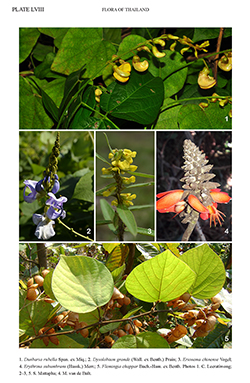e-Flora of Thailand
Volume 4 > Part 3.3 > Year 2023 > Page 575 > Leguminosae-Papilionoideae > Erythrina
6. Erythrina subumbrans (Hassk.) Merr.wfo-0000185021
Philipp. J. Sci., C 5: 113. 1910; Backer & Bakh.f., Fl. Java 1: 628. 1963; Krukoff, J. Arnold Arbor. 20(2): 229. 1939 & 53(1): 130. 1972; Krukoff & Barneby, Lloydia 37(3): 355, t. 13. 1974; Thuân in Aubrév. & J.-F.Leroy, Fl. Cambodge, Laos & Vietnam 17: 25, pl. 2, f. 1–9. 1979; Dassanayake in Dassanayake & Fosberg, Revis. Handb. Fl. Ceylon 7: 248. 1991; R.Sha & M.G.Gilbert in C.Y.Wu et al., Fl. China 10: 238. 2010.— Hypaphorus subumbrans Hassk., Hort. Bogor. Descr.: 198. 1858. Plate LVIII: 4.
Accepted Name : This is currently accepted.
Synonyms & Citations :
Description : Tree 12–15 m tall, evergreen; trunk and main branches usually with prickles; bark smooth, grey or greyish green. Stipules minute, rounded, 2–3 mm in diameter, caducous. Leaves glabrous, membranous; petioles 5.5–17 cm long, without prickles; rachis 2.3–5 cm long. Leaflets: terminal leaflets ovate, 6.5–18.5 by 4.5–13 cm, apex acuminate to caudate, base rounded, broadly cuneate or slightly cordate, margin entire; lateral veins 6–8 pairs, distinctly convex on lower surface; lateral leaflets similar but smaller than the terminal leaflet; stipels glandular, large only on lateral leaflets, cup-like, 3–5 mm in diameter; petiolules 7–10 mm long, usually with minutely hairy. Inforescences axillary or terminal, sub-vertical, 13–25 cm long. Flowers verticillate, with 3 flowers per fascicle; bracts and bracteoles linear-lanceolate, ca 1 mm long, caducous; pedicels 3–4 mm long, woolly pubescent. Calyx campanulate, 2-lobed, 5–10 by 10–15 mm; tube 3–5 mm long; lobes orbicular, 5–7 by 3–7 mm, apex acute, pubescent. Corolla red to orange; standard elliptic, oblanceolate to ovate, 4–6 by 1.5–2.5 cm, apex obtuse, claw ca 6 mm long; wings obliquely obovate, 10–20 by 4–7 mm; keel obliquely broadly obovate, shorter or subequal to wings, 12–16 by 7–10 mm, connate. Stamens 3–6 cm long, glabrescent. Ovary pubescent, short stipitate; style slightly pubescent. Pods basal half flat, without seeds, turgid, 1–5-seeded towards the apex, apex caudate, 8–12 by 1.2–2.5 cm, leathery, glabrescent. Seeds 1–5, sub-reniform, 0.9–1.9 by 0.6–1.4 cm, reddish purple.
Thailand : NORTHERN: Mae Hong Son (Pang Mapha), Chiang Mai (Chiang Dao, Doi Inthanon NP, Fang, Doi Suthep, Mae Taeng, Mae Rim, Om Koi), Chiang Rai (Mae Fa Luang, Ban Pha Mi), Phayao (Chiang Kham), Nan (Song Kae), Lamphun (Doi Khun Tan), Lampang (Phan), Uttaradit (Phu Soi Dao NP), Phitsanulok (Chat Trakan); CENTRAL: Krung Thep Maha Nakhon (Bangkok), Saraburi, Nakhon Nayok (Khao Yai NP); SOUTH-WESTERN: Kanchanaburi (Wang Ka); SOUTH-EASTERN: Chon Buri (Si Racha).
Distribution : India, Sri Lanka, Myanmar, China, Laos, Vietnam, Malaysia, Indonesia (type), the Philippines, Timor.
Ecology : Dry evergreen and evergreen forests, occasionally found by streams, edges of forest; to 1,300 m alt. Flowering: February–May; fruiting: April–August.
Vernacular : Thong mit khut (ทองมีดขูด), thong lang pa (ทองหลางป่า)(Northern); thong lang (ทองหลาง)(Central).

